Page 6 of 280
�Î
�Î
�Π: If equipped
Your Vehicle at a Glance
Your Vehicle at a Glance
3
A/T model is shown. AUDIO SYSTEM
GAUGES
AUTOMATIC TRANSMISSION
PASSENGER AIRBAG OFF
INDICATOR INSTRUMENT PANEL
INDICATORS
PASSENGER’S FRONT
AIRBAG
PARKING BRAKE MANUAL TRANSMISSION
(P.9,25)
MIRROR CONTROLS
POWER DOOR LOCK
MASTER SWITCH
(P.31)
HOOD RELEASE HANDLE (P.9,31)
(P.60)
(P.67)
(P.79) (P.94)
(P.138)
ACCESSORY POWER SOCKET
(P.99) (P.96) (P.157)
(P.155)
(P.102)
(P.107)
HAZARD WARNING
BUTTON
(P.74)
DRIVER’S FRONT
AIRBAG
(P.95)
POWER WINDOW
SWITCH HEATING/COOLING
CONTROLS
�����—�����—�����y������
��������y���
�(�������
���y���������y
2008 Fit
Page 56 of 280
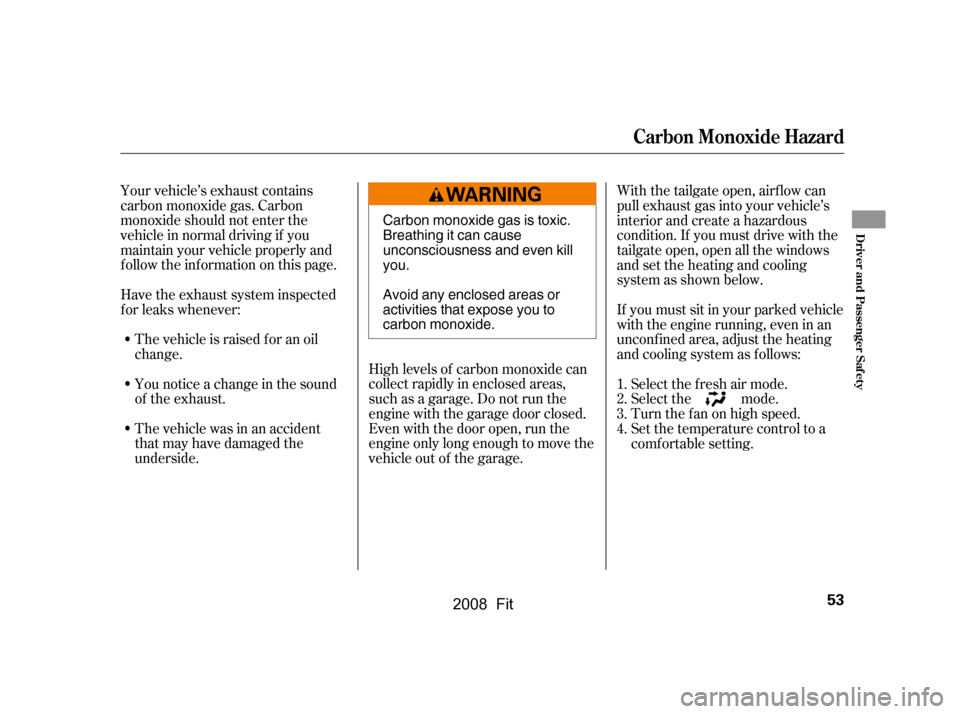
Your vehicle’s exhaust contains
carbon monoxide gas. Carbon
monoxide should not enter the
vehicle in normal driving if you
maintain your vehicle properly and
f ollow the inf ormation on this page.
Have the exhaust system inspected
f or leaks whenever:High levels of carbon monoxide can
collect rapidly in enclosed areas,
such as a garage. Do not run the
engine with the garage door closed.
Even with the door open, run the
engine only long enough to move the
vehicle out of the garage.
The vehicle is raised f or an oil
change.
You notice a change in the sound
of the exhaust.
The vehicle was in an accident
that may have damaged the
underside. With the tailgate open, airflow can
pull exhaust gas into your vehicle’s
interior and create a hazardous
condition. If you must drive with the
tailgate open, open all the windows
and set the heating and cooling
system as shown below.
If you must sit in your parked vehicle
with the engine running, even in an
unconf ined area, adjust the heating
and cooling system as f ollows:
Select the f resh air mode.
Select the mode.
Turn the f an on high speed.
Set the temperature control to a
comfortable setting.
1.
2.
3.
4.
Carbon Monoxide Hazard
Driver and Passenger Saf ety
53
Carbon monoxide gas is toxic.
Breathing it can cause
unconsciousness and even kill
you.
Avoid any enclosed areas or
activities that expose you to
carbon monoxide.
�\f���—�\f���—�����y���\f�������
���y���
�(�������
�\f�y�\f�\f�����y
2008 Fit
Page 61 of 280
�Î
�Î
�Π: If equipped
Control L ocations
58
MIRRORCONTROLS
(P.95)
POWER WINDOW
SWITCH
HOOD RELEASE
HANDLE
POWER DOOR
LOCK MASTER
SWITCH
(P.79)
(P.94)
(P.138)
ACCESSORY POWER
SOCKET
GAUGES
INSTRUMENT PANEL
INDICATORS
(P.60)
(P.67)
AUTOMATIC TRANSMISSION
MANUAL TRANSMISSION
(P.157)
(P.155)AUDIO SYSTEM
HEATING/COOLING
CONTROLS
(P.102)
HAZARD WARNING BUTTON
PASSENGER AIRBAG
OFF INDICATOR PARKING BRAKE
(P.31)(P.99) (P.96)(P.107)
(P.74)
�\f���—�\f���—�����y���\f�����������y���
�(�������
�\f�y�\f�\f�����y
2008 Fit
Page 66 of 280
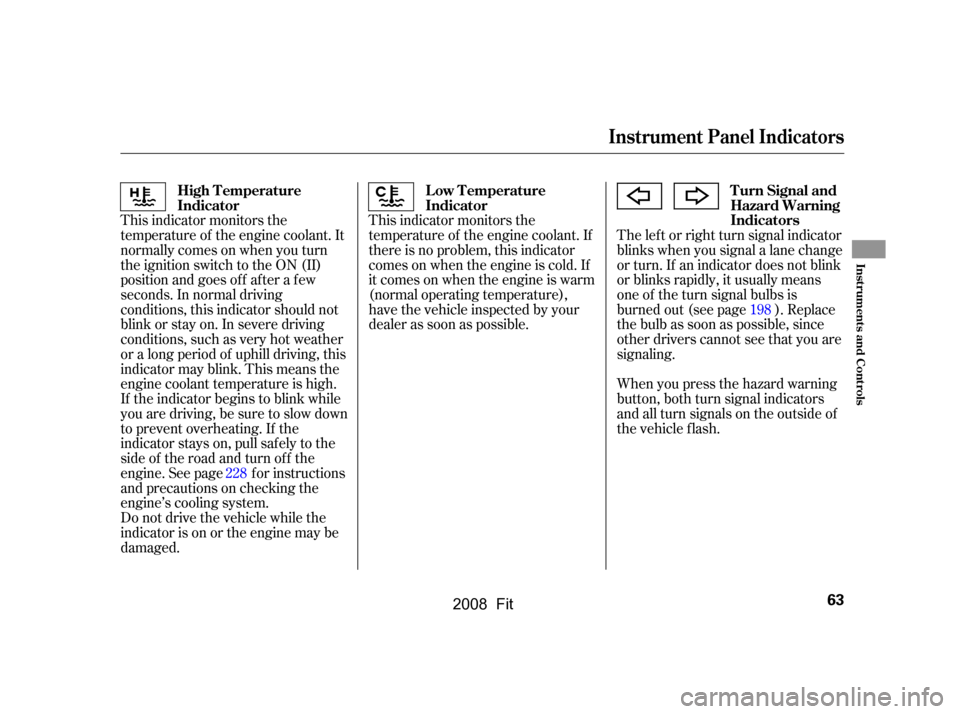
This indicator monitors the
temperature of the engine coolant. It
normallycomesonwhenyouturn
the ignition switch to the ON (II)
position and goes of f af ter a f ew
seconds. In normal driving
conditions, this indicator should not
blink or stay on. In severe driving
conditions, such as very hot weather
or a long period of uphill driving, this
indicator may blink. This means the
engine coolant temperature is high.
If the indicator begins to blink while
you are driving, be sure to slow down
to prevent overheating. If the
indicator stays on, pull safely to the
side of the road and turn of f the
engine. See page f or instructions
and precautions on checking the
engine’s cooling system.This indicator monitors the
temperature of the engine coolant. If
there is no problem, this indicator
comes on when the engine is cold. If
it comes on when the engine is warm
(normal operating temperature),
have the vehicle inspected by your
dealer as soon as possible.
Do not drive the vehicle while the
indicator is on or the engine may be
damaged. The lef t or right turn signal indicator
blinks when you signal a lane change
or turn. If an indicator does not blink
or blinks rapidly, it usually means
one of the turn signal bulbs is
burned out (see page ). Replace
the bulb as soon as possible, since
other drivers cannot see that you are
signaling.
When you press the hazard warning
button, both turn signal indicators
and all turn signals on the outside of
the vehicle f lash.
228 198
Instrument Panel Indicators
High T emperature
Indicator
Low Temperature
Indicator Turn Signal and
Hazard Warning
Indicators
Inst rument s and Cont rols
63
�\f���—�\f���—�����y���\f���������\f�y���
�(�������
�\f�y�\f�\f�����y
2008 Fit
Page 106 of 280
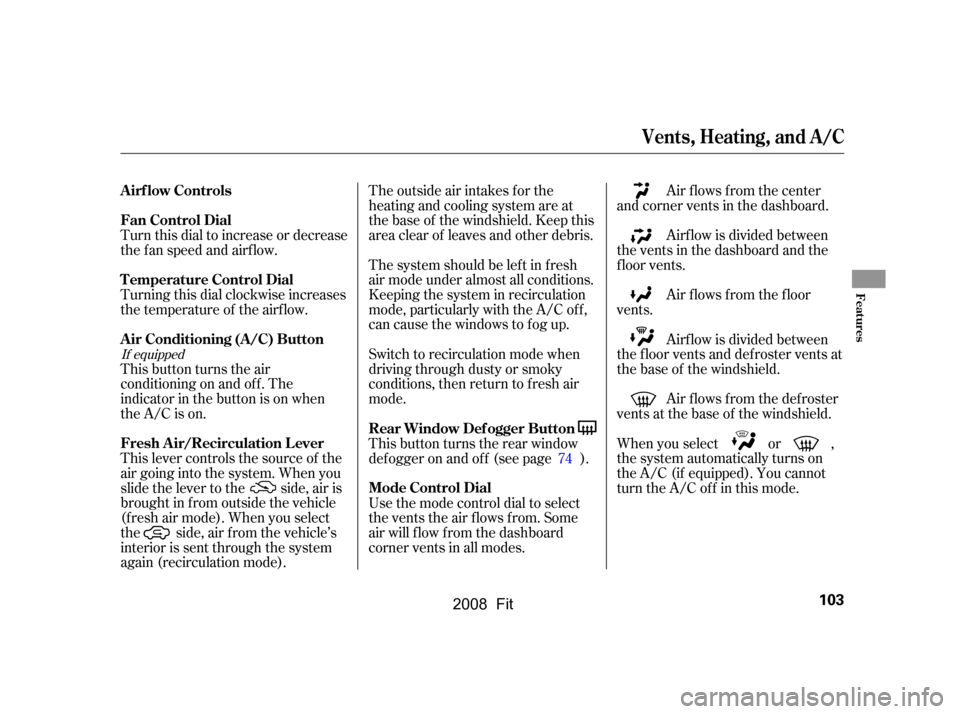
The outside air intakes f or the
heating and cooling system are at
the base of the windshield. Keep this
area clear of leaves and other debris.
Thesystemshouldbeleftinfresh
air mode under almost all conditions.
Keeping the system in recirculation
mode, particularly with the A/C of f ,
can cause the windows to fog up.
Switch to recirculation mode when
driving through dusty or smoky
conditions, then return to fresh air
mode.
Turning this dial clockwise increases
the temperature of the airflow.
Turn this dial to increase or decrease
the fan speed and airflow.
This button turns the air
conditioning on and of f . The
indicatorinthebuttonisonwhen
the A/C is on.
This lever controls the source of the
air going into the system. When you
slide the lever to the side, air is
brought in f rom outside the vehicle
(f resh air mode). When you select
the side, air f rom the vehicle’s
interior is sent through the system
again (recirculation mode).
Use the mode control dial to select
the vents the air flows from. Some
air will f low f rom the dashboard
corner vents in all modes. Airf low is divided between
the vents in the dashboard and the
f loor vents.
Air f lows f rom the f loor
vents. Air flows from the center
and corner vents in the dashboard.
Air f lows f rom the def roster
vents at the base of the windshield. Airf low is divided between
the f loor vents and def roster vents at
the base of the windshield.
When you select or ,
the system automatically turns on
the A/C (if equipped). You cannot
turn the A/C of f in this mode.
This button turns the rear window
def ogger on and of f (see page ).
74
If equipped
Rear Window Def ogger Button
Air Conditioning (A/C) Button
T emperature Control Dial
Fan Control Dial
Fresh A ir/Recirculation L ever
Mode Control Dial
A irf low Controls
Vents, Heating, and A/C
Features
103
�\f���—�\f���—�����y���\f���������
�y���
�(�������
�\f�y�\f�
�\f���y
2008 Fit
Page 193 of 280
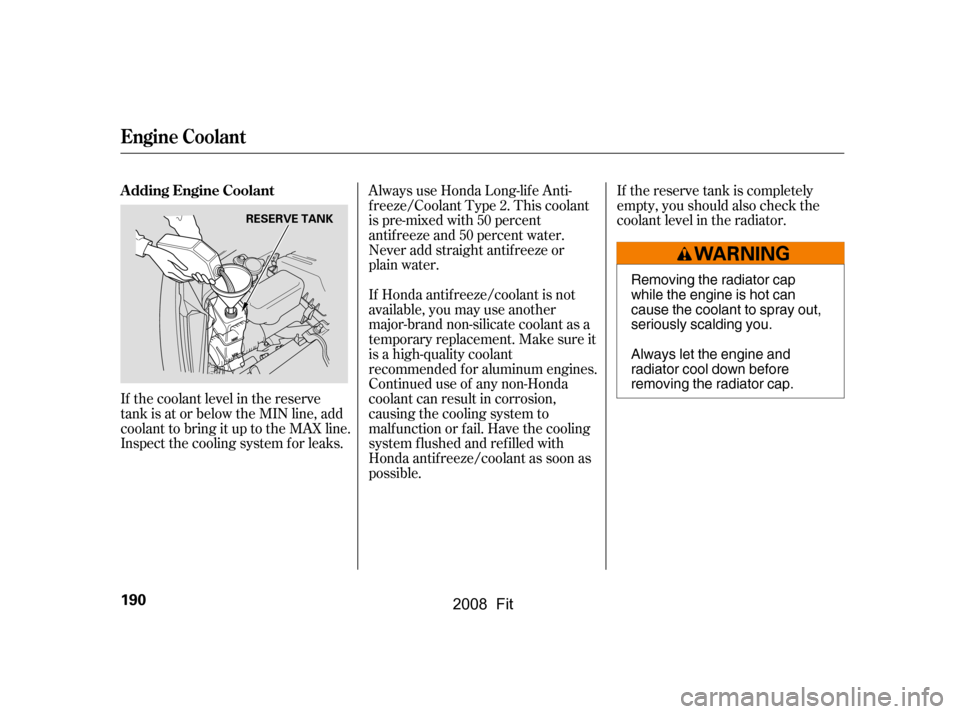
If Honda antif reeze/coolant is not
available, you may use another
major-brand non-silicate coolant as a
temporaryreplacement.Makesureit
is a high-quality coolant
recommended f or aluminum engines.
Continued use of any non-Honda
coolant can result in corrosion,
causing the cooling system to
malf unction or f ail. Have the cooling
system f lushed and ref illed with
Honda antif reeze/coolant as soon as
possible.If the reserve tank is completely
empty, you should also check the
coolant level in the radiator.
If the coolant level in the reserve
tank is at or below the MIN line, add
coolant to bring it up to the MAX line.
Inspect the cooling system f or leaks. Always use Honda Long-lif e Anti-
f reeze/Coolant Type 2. This coolant
is pre-mixed with 50 percent
antif reeze and 50 percent water.
Never add straight antifreeze or
plain water.
Engine Coolant
A dding Engine Coolant
190
RESERVE TANK
Removing the radiator cap
while the engine is hot can
cause the coolant to spray out,
seriously scalding you.
Always let the engine and
radiator cool down before
removing the radiator cap.
�\f���—�\f���—�����y���\f����\f����\f�y���
�(�������
�\f�y�\f�
�����y
2008 Fit
Page 194 of 280
The coolant level should be up to
the base of the f iller neck. Add
coolant if it is low.
Pourthecoolantslowlyand
caref ully so you do not spill any.
Clean up any spill immediately; it
could damage components in the
engine compartment.Do not add any rust inhibitors or
other additives to your vehicle’s
cooling system. They may not be
compatible with the coolant or
engine components.
Pour coolant into the reserve tank.
Fill it half way between the MAX
and MIN marks. Put the cap back
on the reserve tank.
Make sure the engine and radiator
are cool.
Relieve any pressure in the cooling
system by turning the radiator cap
counterclockwise, without
pressing down.
Remove the radiator cap by
pushing down and turning
counterclockwise. Put the radiator cap back on, and tighten it fully.
3. 4.
2.
1.
5.6.
Engine Coolant
Maint enance
191
RADIATOR CAP
RESERVE TANK
�\f���—�\f���—�����y���\f����\f������y���
�(�������
�\f�y�\f�
�����y
2008 Fit
Page 208 of 280
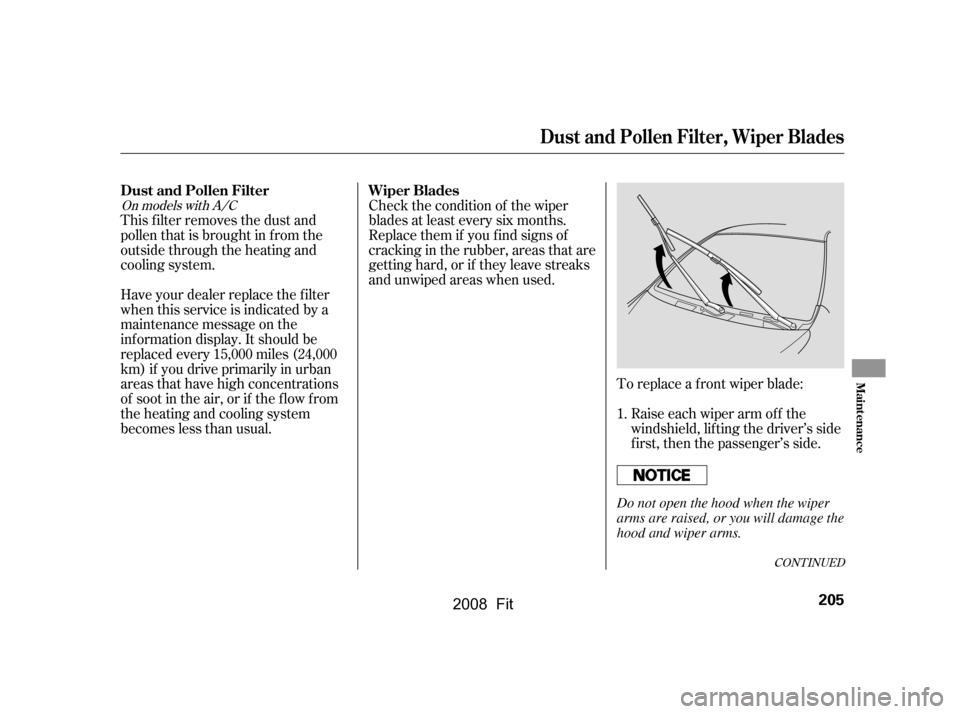
Check the condition of the wiper
blades at least every six months.
Replace them if you f ind signs of
cracking in the rubber, areas that are
getting hard, or if they leave streaks
and unwiped areas when used.
This f ilter removes the dust and
pollenthatisbroughtinfromthe
outside through the heating and
cooling system.
Have your dealer replace the filter
when this service is indicated by a
maintenance message on the
inf ormation display. It should be
replaced every 15,000 miles (24,000
km) if you drive primarily in urban
areas that have high concentrations
of soot in the air, or if the f low f rom
the heating and cooling system
becomeslessthanusual.
To replace a f ront wiper blade:
Raise each wiper arm off the
windshield, lif ting the driver’s side
first, then the passenger’s side.
1.
CONT INUED
On models with A/C
Wiper Blades
Dust and Pollen Filter
Dust and Pollen Filter, Wiper Blades
Maint enance
205
Do not open the hood when the wiper
arms are raised, or you will damage the
hood and wiper arms.
�\f���—�\f���—�����y���\f���������\f�y���
�(�������
�\f�y�\f���
�\f�y
2008 Fit